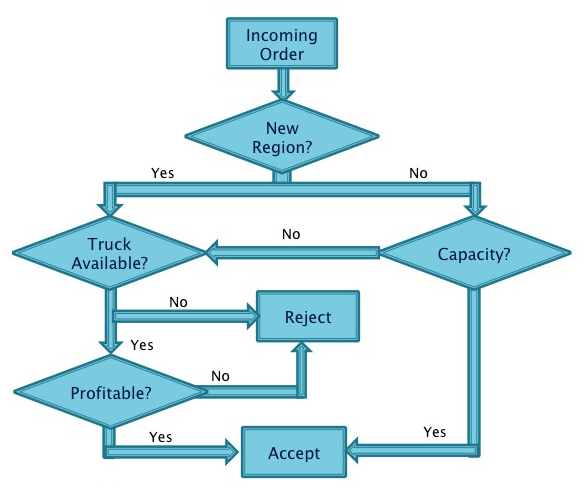Editor’s Note: Every year, the students in the MIT Center for Transportation & Logistics’ (MIT CTL) Master of Supply Chain Management (SCM) program complete one-year thesis research projects. The students are early-career business professionals from multiple countries with 2 to 10 years of experience in the industry. The research projects are sponsored by and carried out in collaboration with multinational corporations. Joint teams of company people, MIT SCM students, and MIT CTL faculty work on real-world problems chosen by the sponsoring companies. In this monthly, series we summarize a selection of the latest SCM research. The researchers for the project described below, Hiral Nisar and Joshua Rosenzweig, looked at the problem for their master’s thesis Real-Time Order Acceptance in Transportation Under Uncertainty. The work was supervised by Dr. Chris Caplice, Executive Director, MIT CTL. For more information on the program, visit http://scm.mit.edu/programhttp://scm.mit.edu/program.
In the freight transportation industry, economies of scale can be achieved by aggregating similar loads in geographic areas that are in close proximity to each other. However, since companies don’t know future demand, it can be difficult to gauge whether or not loads should be accepted, particularly where unfamiliar geographies are involved.
For this project, the researchers wanted to create and validate a model to determine if historical demand data can be used by retail firms operating private fleets to make effective order acceptance/rejection decisions in real time. The model would help companies eliminate unprofitable orders in a short-haul transportation environment. They developed a Java tool that decides in an instant whether or not to accept loads depending on the order location and time of receipt.
Pathways to a verdict
Key to determining the viability of shipments is whether they meet the firm’s profitability requirements. And this determination has to be made relatively quickly as the orders are received.
The decision-making criteria used by the model reflect these market realities. There are two main criteria: the breakeven number of orders required, and the probability of receiving that many orders during the time remaining in the acceptance period. Carrier availability is also factored into the process.
Figure 1 shows the decision-making tree that companies navigate as they make these evaluations. As can be seen, incoming orders for new regions are reviewed in terms of the expected profitability of deploying trucks in relevant geographies. In the event that there is no service history to draw on, the model determines the likelihood of receiving a breakeven number of orders within the acceptance period. If that number exceeds the predetermined threshold and truck space is available, the model accepts orders until the allocated capacity is fully utilized.

Contrasting options
The researchers validated the probabilistic model by comparing its performance to that of other models.
Optimal Model. The baseline for comparison purposes, this model assumes that the company has complete knowledge of all daily orders before making rejection/acceptance decisions. Capacity utilization is optimized, and profitability is maximized.
Myopic Manager Model. In this option, orders are accepted sequentially until carrying capacity is filled. As is the case with the probabilistic model, decisions are made instantaneously when orders are received. This model reflects the actions of a firm with no intelligent operational decision-making process, and as such, simulates a worst-case scenario.
Logistics Regression Model. This model uses operational variables and data on previous decisions to accept or reject orders instantaneously. The variables used are the distance of incoming orders from the distribution center and order size.
Using simulated demand data as an input, the Java tool determined that the probabilistic model developed by the researchers delivered about 8% less profit than the optimal solution with a flexible fleet size. However, it outperformed all of the other models. The average daily profit for the myopic manager and logistics regression options were about 11% and 34% below the optimum respectively.
Learn from the past
The research shows that demand probabilities determined by historical demand patterns should be considered by companies with private fleets when deciding whether or not to accept orders under capacity constraints.
However, more research is needed to gain a better understanding of how the model performs in real-world applications. For example, the model can be refined with the addition of more detailed data on order frequency, size, and revenue, and the cost of order rejections should be accounted for in future research.
For further information on the research contact Dr. Bruce Arntzen, Executive Director, MIT Supply Chain Management Program, at [email protected].
SC
MR

Latest Supply Chain News
- How S&OP provides the answer to in-demand products
- AI, virtual reality is bringing experiential learning into the modern age
- Humanoid robots’ place in an intralogistics smart robot strategy
- Tips for CIOs to overcome technology talent acquisition troubles
- There is still work to do to achieve supply chain stability
- More News
Latest Podcast

 Explore
Explore
Latest Supply Chain News
- How S&OP provides the answer to in-demand products
- AI, virtual reality is bringing experiential learning into the modern age
- Humanoid robots’ place in an intralogistics smart robot strategy
- Tips for CIOs to overcome technology talent acquisition troubles
- There is still work to do to achieve supply chain stability
- Blooming success: The vital role of S&OE in nurturing global supply chains
- More latest news
Latest Resources

Subscribe

Supply Chain Management Review delivers the best industry content.

Editors’ Picks





